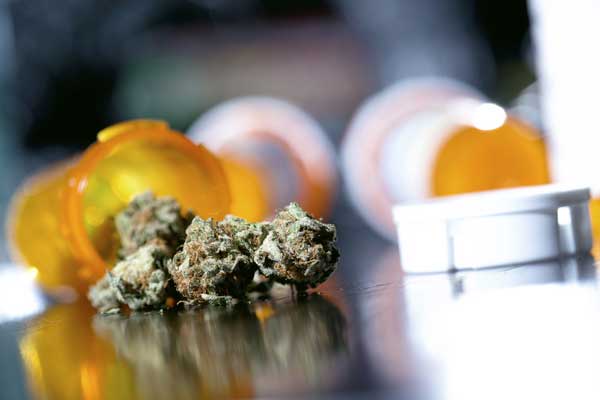Cannabis and pain - A great overview

Pain affects the body and the mind, affecting quality of life and general well-being in very significant ways. Pain can cause unpleasant sensory stimuli or emotional experiences.
Pain is one of the most important reasons why people seek medical help. It can have very different dimensions and manifest itself in different ways. There is neuropathic pain, which is mostly chronic, and temporary pain. Pain very often occurs in connection with certain diseases (cancer, neuropathy) or as a result of accidents.
Classically, pain treatment begins with a search for the causes. After diagnosis and testing, treatment consists of pharmaceutical medication that targets the main causes and suppresses the pain itself.
In the treatment of pain, drugs such as aspirin, ibuprofen or opioid-based drugs are prescribed, which can often have significant and serious side effects, especially if they have to be taken over a long period of time for chronic pain. While the short-term use of opioids can be effective and indicated for certain diseases, their prolonged use leads to an increased risk of dependence, even if this is still often denied by the medical community.
Among the very questionable and increased dangerous drugs prescribed for pain are the opioids oxycodone and fentanyl, which led to nearly 10,000 deaths in the US alone in 7 years. A frightening result.
It is not always easy for medicine to control and treat certain pains and diseases. Even with the use of questionable pain medications, the results for some patients remain unsatisfactory and the quality of life is still significantly reduced.
Cannabis has a long history in medicine

Within the last 5000 years, cannabis has been used as an analgesic in almost all ancient cultures, from the Sumerian culture to China, Babylon, the Indus Valley, the Judeans, Greeks and Islamic cultures. The important role of cannabis within medicine continued into early Western medicine. Cannabis has remained significant and medicinally valuable in the context of treating pain to this day, even though it has been declared illegal in many parts of the world. Marijuana continues to serve as an anti-inflammatory and mind and body relaxant to this day.
Recently, significant research has been conducted around the topic of cannabis as a therapy in the treatment of chronic pain, with promising results. Current research in the field confirms that cannabis is safe and effective in the treatment of both chronic pain and so-called nociceptor pain (in short, pain that persists despite treatment of the underlying condition). While hundreds of studies and modern scientific data support the analgesic properties of cannabis, some publications have also explained the complex neurochemical work of cannabinoids on pain within the human nervous system. Science made a relatively new discovery and found the endocannabinoid system that the human body itself possesses. Endogenous or external cannabinoids like those found in cannabis signal the cannabinoid receptors in the body to regulate a wide variety of bodily processes, including the sensation of pain. There are 2 types of receptors, cannabinoid receptor I and II (CB1 and CB2), which are associated with specific regulatory functions.
The CB1 receptors are located in the central nervous system (brain and spinal cord), which controls information received through the senses and enables responses and certain behaviours. These receptors can be located in parts of the brain where motor control, attention, emotions, thinking, habits and memory (hippocampus) are regulated. In addition, they have also been found in the male and female reproductive systems.
At this point, it is important to point out that CB1 receptors are absent in parts of the brain that regulate heart and respiratory function. This makes cannabis much safer for patients than opiates, which in turn can cause physical harm and even death by causing respiratory distress and weakness.
Cannabinoids cannot replace the strong analgesic effect of opiates, especially in acute injury and trauma. However, cannabinoids can lead to a reduced need for opiates when used together. Thus, there may be a synergistic effect between cannabinoids and opiates while reducing the risk of adverse effects and dependence. (7)
CB2 receptors are increasingly located in the periphery of the body, especially in tissues involved in immune reactions. The spleen, for example, has a high concentration of CB2 receptors. This makes the involvement of CB2 receptors important in the treatment of chronic pain associated with autoimmune diseases. In these diseases, the body's own immune system switches itself on.
Numerous plant-based cannabinoids and other plant components (non-cannabinoids), synthetic cannabinoids and those produced by the body itself are significantly involved in reducing inflammation. This often goes hand in hand with autoimmune diseases.
A review of existing studies (2004-2009) shows that cannabinoids can effectively relieve pain in which inflammation plays a role, e.g. rheumatism, arthritis, chronic neuropathy, fibromyalgia.
Compared to the other pharmaceutical treatment options, cannabis has a unique distinction: it has been safe for pain management for over 4 millennia. No fatalities, no direct toxicity, have ever been documented in the medical literature.
In addition to its anti-inflammatory and analgesic abilities, and its potential to reduce the use of opiates, cannabis also reduces painful spasms, decreases anxiety that can be associated with pain, and promotes relaxation and sleep. It can gently improve mood, which is a significant factor in the healing process.
Three interesting study on the effectiveness of cannabis in pain management
A study in Worcester, Massachusetts (2009) did a broad review of the relevant studies on cannabinoids and their use in pain management, looking at all studies published within the last 5 years on the activities and properties of all types of cannabinoids. The endogenous cannabinoids such as anandamides were included, as well as non-cannabinoids and components in cannabis that have anti-inflammatory activities.
The results showed that all types of cannabinoids and also the non-cannabinoid plant components of cannabis can effectively reduce pain due to inflammation, such as in rheumatism, arthritis, neuropathy.
Studies show many times that cannabinoids can also reduce neuropathic pain. A randomised, placebo-controlled, double-blind crossover study from Rome (Italy 2009) looking at patients suffering from MS was the first to look at the influence of cannabinoids on nociceptive pain using reflex testing. The authors conclude that cannabinoids modulate the nociceptive system in patients with MS.
A study from San Diegon shows the importance of dosage in therapeutic use. A randomised, double-blind, placebo-controlled cross study was conducted in patients. Fifteen healthy participants received capsaicin injections, a component of cayenne pepper that is also responsible for the spiciness. The injections were given at 5- and 45-minute intervals after smoking cannabis, which had 3 different concentrations (2%, 4% and 8% THC).
The scientists measured the participants' pain level and pain threshold. The result underlines the importance of dosage in pain management. 5 minutes after cannabis administration, there was no effect on capsaicin-induced pain, regardless of the dosage. At 45 minutes after cannabis administration, there was a sudden significant decrease in capsaicin-induced pain at the medium dosage. The high dosage showed rather counterproductive effects.
Patients are advised to start with a lower dosage of cannabis and slowly increase it until the most effective and appropriate therapeutic window is found.
One's therapeutic window is largely dependent on 3 factors: the body's current endocannabinoid system, the cannabinoid profile of the cannabis used and the method of consumption.
Patients affected by neurological diseases often have a deficiency of CB1 activity. In certain immune diseases and chronic inflammations, there is often a lack of C2 activity. In this context, a cannabis strain that either has a higher THC:CBD ratio or a lower one is selected to address the specific deficiency.
Migraine, fibromyalgia, IBS and their associated manifestations show common clinical, biochemical and pathophysiological patterns that suggest an underlying clinical endocannabinoid deficiency that can be treated with cannabinoids (Missoula 2004, Ethan Russo).
Using cannabis correctly for pain

The use of vaporizers produces direct and immediate effects, whereas oral ingestion, especially when the stomach is full, is more difficult to dose and may take hours to show effects. When inhaling cannabis smoke or vaping, it is recommended to wait 5 to 10 minutes first. Then observe how you feel. Is the dosage used having the desired effect? If not, you can inhale a second time and wait another 5-10 minutes. One should not be impatient here. The line between an effective dose and undesirable effects (such as drowsiness) can be very thin. The described procedure should be followed until the ideal dosage is found. At this point, the intake should be stopped. Much is not necessarily always better.
When taking cannabis orally, many patients make the mistake of not noticing anything at first and therefore eat even more. After some time, the effect sets in very violently and can last for several hours. This is not dangerous, but it can make you feel very low, sleepy, confused and unable to move. This is a state that many patients do not want to be in. Therefore, it is helpful to always proceed slowly and in a well-dosed manner and to wait until the effect sets in before adding more.
Strain specific considerations
THC binds relatively equally with CB1 and CB2 receptors. Sativas and sativa-dominant strains usually have a higher THC:CBD ratio. Medical cannabis is based on the 3 types indica, sativa and ruderalis. Individual medical cannabis strains are created by breeding and crossing these species. Each cannabis strain and even each individual plant has its own very unique terpene and cannabinoid profile. Different cannabis strains and cannabinoid profiles have different effects in treating pain. Some strains work more for certain patients than others. Many patients benefit from the use of different marijuana strains and thus cover a broader spectrum of effects.
In general, the cannabis strains that are considered most effective in treating pain are those that are high in THC or CBD. These can be indicas, sativas or hybrids (a mixture of both). It always depends on the use and personal experience and circumstances. Indicas are used by patients in the evening for relaxation and sleep, while sativas are used during the day because they do not make you tired or heavy.
Neuropathy and pain
Neuropathy is pain generally caused by nerve damage. Either by external injury such as heat, cold or chemicals, or by (progressive) disease or nutrient deficiency.
A randomised controlled trial from the University of California at San Diego has shown that cannabis, when inhaled, can reduce neuropathic (diabetic) pain for several hours. The researchers found that the higher the dose, the greater the pain relief. Lead author was Mark Wallace, chair of the Department of Pain Management at the University of California, San Diego.
According to Dr Wallace, there is a lot of evidence for the positive effect of cannabis on the treatment of neuropathic pain. However, further studies are needed that look even more into the different dosages and possibilities.
The majority of randomised, placebo-controlled cross studies on the effects of cannabis on neuropathic pain published between 2004 and 2009 found a clear therapeutic effect with few and easily manageable side effects. The majority of scientific studies demonstrated the efficacy of cannabis in the treatment of pain.
Also, Dr. Robert Sullivan, one of the first physicians to offer cannabis consultations in Orange County California, reports that his patients have seen a significant reduction and even cessation in their use of opiates, muscle relaxants, anti-depressants, sleeping pills and anti-inflammatories. These are all drugs that can cause serious side effects.
Patients who cannot live without opiates very often report a reduction of opiates by about 50% when taking cannabis at the same time. Animal experiments in the laboratory came to similar results.
Not only the cannabinoids THC and CBD are helpful in relieving pain. The flavour and aroma molecules of cannabis (terpenes) are also useful and effective against pain. So the intense skunk aroma of your plants also shows their medicinal benefits.
Cannabinoids in marijuana with pain-relieving effects

Pain-relieving effects have already been shown for various cannabinoids found in cannabis. These include the following cannabinoids:
THC
- analgesic, anti-inflammatory, sleep-inducing, reduces muscle spasms
- psychoactive
- relaxing, calming
CBD
- Pain relief
- sleep-inducing
- anti-inflammatory
- Reduces spasms
- non-psychoactive
CBN
- Pain relief
- sleep-inducing
- anti-inflammatory
CBC
- analgesic
- anti-inflammatory
CBG
- analgesic
- anti-inflammatory
To date, around 100 cannabinoids have been discovered in cannabis, these are also called phytocannabinoids and many are thought to have medicinal benefits. In addition to cannabinoids, the cannabis plant biosynthesises hundreds of other substances that may also have therapeutic benefits.
Terpenes like those found in cannabis are also found in other plants. The terpene cannflavin-A, cannflavin-B and -C are only found in marijuana.
Marijuana is not only a powerful antioxidant, it is also loaded with medicinally valuable terpenes that vary by strain and depend on the individual terpene profile of a cannabis plant.
Marijuana also relieves pain resulting from injuries to muscles and tendons. Many cannabis strains help in the treatment of musculoskeletal disorders. Numerous patients have had very good experiences with cannabis-infused creams and ointments applied locally to affected areas.
Comment
Considerations to only make medical cannabis available to those affected and to only enable and allow treatment when much more questionable medications have failed cannot be in the interest of the patients and their illness. The fact that riskier and more precarious medicines are preferred to the largely harmless cannabis is incomprehensible and not based on current modern research, which should not be disregarded. Every patient should be able to decide for himself which and how much risk he wants to take in the context of a necessary treatment. Patients must have the right to choose the safer medicine/cannabis.
Barth Wilsey, MD, Director of the University of California at Davis Analgesic Research Center, et al, stated the following in his June 2008 study titled "A Randomized, Placebo Controlled Cross-Over Trial of Cannabis Cigarettes in Neuropathic Pain," published in the Journal of Pain
Mark Wallace, MD, Professor of Anesthesiology at the University of California at San Diego, et al, stated the following in their Nov. 2007 article titled "Dose-Dependent Effects of Smoked Cannabis on Capsaicin-Induced Pain and Hyperalgesia in Healthy Volunteers," published in the journal Anesthesiology
Jonathan S. Berman, MA, Consulting Anaesthetist at the Royal National Orthopaedic Hospital, et al, wrote the following in a Dec. 2004 article titled "Efficacy of Two Cannabis Based Medicinal Extracts for Relief of Central Neuropathic Pain from Brachial Plexus Avulsion: Results of a Randomised Controlled Trial" in the journal Pain
Mark A. Ware, MD, MSc, et al, stated the following in their Aug. 30, 2010 study titled "Smoked Cannabis for Chronic Neuropathic Pain: A Randomized Controlled Trial," published in the Canadian Medical Association Journal
These articles might also interest you:
- Make your own cannabis anti-pain ointment
- Varieties for the treatment of chronic pain
- Different ways of taking medicinal cannabis
- Medical Cannabis and Painful Neuropathy





